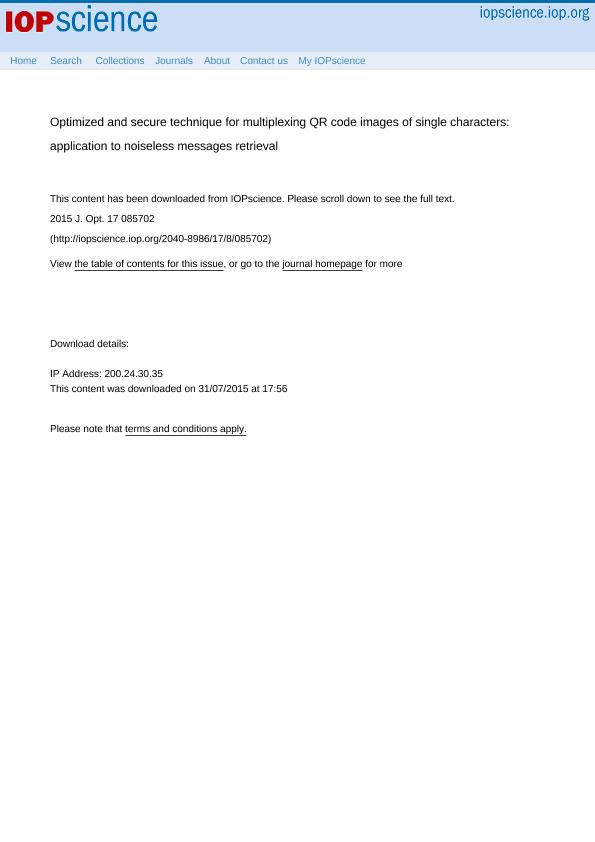Mostrar el registro sencillo del ítem
dc.contributor.author
Trejos, Sorayda
dc.contributor.author
Barrera, John Fredy
dc.contributor.author
Torroba, Roberto Daniel

dc.date.available
2017-01-24T18:15:32Z
dc.date.issued
2015-07
dc.identifier.citation
Trejos, Sorayda; Barrera, John Fredy; Torroba, Roberto Daniel; Optimized and secure technique for multiplexing QR code images of single characters: application to noiseless messages retrieval; IOP Publishing; Journal of Optics; 17; 8; 7-2015; 1-9; 085702
dc.identifier.issn
2040-8978
dc.identifier.uri
http://hdl.handle.net/11336/11825
dc.description.abstract
We present for the first time an optical encrypting–decrypting protocol for recovering messages without speckle noise. This is a digital holographic technique using a 2f scheme to process QR codes entries. In the procedure, letters used to compose eventual messages are individually converted into a QR code, and then each QR code is divided into portions. Through a holographic technique, we store each processed portion. After filtering and repositioning, we add all processed data to create a single pack, thus simplifying the handling and recovery of multiple QR code images, representing the first multiplexing procedure applied to processed QR codes. All QR codes are recovered in a single step and in the same plane, showing neither cross-talk nor noise problems as in other methods. Experiments have been conducted using an interferometric configuration and comparisons between unprocessed and recovered QR codes have been performed, showing differences between them due to the involved processing. Recovered QR codes can be successfully scanned, thanks to their noise tolerance. Finally, the appropriate sequence in the scanning of the recovered QR codes brings a noiseless retrieved message. Additionally, to procure maximum security, the multiplexed pack could be multiplied by a digital diffuser as to encrypt it. The encrypted pack is easily decoded by multiplying the multiplexing with the complex conjugate of the diffuser. As it is a digital operation, no noise is added. Therefore, this technique is threefold robust, involving multiplexing, encryption, and the need of a sequence to retrieve the outcome.
dc.format
application/pdf
dc.language.iso
eng
dc.publisher
IOP Publishing

dc.rights
info:eu-repo/semantics/openAccess
dc.rights.uri
https://creativecommons.org/licenses/by-nc-sa/2.5/ar/
dc.subject
Qr Codes
dc.subject
Optical Packaging
dc.subject
Image Processing
dc.subject
Multiplexing
dc.subject
Digital Holography
dc.subject.classification
Óptica

dc.subject.classification
Ciencias Físicas

dc.subject.classification
CIENCIAS NATURALES Y EXACTAS

dc.title
Optimized and secure technique for multiplexing QR code images of single characters: application to noiseless messages retrieval
dc.type
info:eu-repo/semantics/article
dc.type
info:ar-repo/semantics/artículo
dc.type
info:eu-repo/semantics/publishedVersion
dc.date.updated
2017-01-24T14:43:16Z
dc.identifier.eissn
2040-8986
dc.journal.volume
17
dc.journal.number
8
dc.journal.pagination
1-9; 085702
dc.journal.pais
Reino Unido

dc.journal.ciudad
Bristol
dc.description.fil
Fil: Trejos, Sorayda. Universidad de Antioquia; Colombia
dc.description.fil
Fil: Barrera, John Fredy. Universidad de Antioquia; Colombia
dc.description.fil
Fil: Torroba, Roberto Daniel. Consejo Nacional de Investigaciones Científicas y Técnicas. Centro Científico Tecnológico la Plata. Centro de Investigaciones Opticas (i); Argentina. Provincia de Buenos Aires. Gobernación. Comisión de Investigaciones Científicas; Argentina. Universidad Nacional de La Plata. Facultad de Ingenieria; Argentina
dc.journal.title
Journal of Optics
dc.relation.alternativeid
info:eu-repo/semantics/altIdentifier/doi/http://dx.doi.org/10.1088/2040-8978/17/8/085702
dc.relation.alternativeid
info:eu-repo/semantics/altIdentifier/url/http://iopscience.iop.org/article/10.1088/2040-8978/17/8/085702/meta
Archivos asociados
